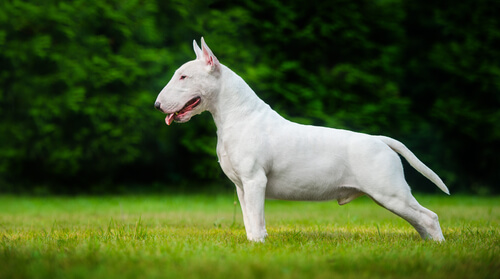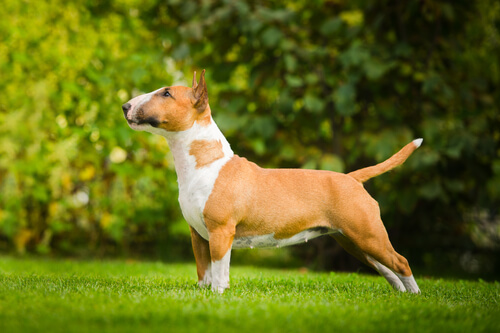
| Kingdom | Animalia |
| Phylum | Chordata |
| Class | Mammalia |
| Order | Carnivora |
| Family | Canidae |
| Genus | Canis |
| Species | C. lupus |
| Species | C. lupus familiaris |
| Niche | Domestic |
| Height | 10-22 inches (25-55 cm) |
| Weight | 25-75 lbs (7-35 kg) |
| Lifespan | 10-14 years |
| Social Structure | Social, domesticated |
| Breed Status | Common |
| Preferred Habitat | Domestic |
| Average Litter Size | 5 puppies |
| Main Food Item | Dog Food |
The Basics
The bull terrier is a medium-sized breed of domestic dog developed in the 1800s as a fighting dog. Later, it was used as a status symbol and companion and then finally as a common family pet and show dog. They are known for their long, rounded snouts and loyal temperament.
Bull terriers are bred in two varieties, standard and miniature. The standard variety typically weighs 35-75 lb (15-35 kg) and stands 21-22 in (53-55 cm) tall at their withers. The miniature bull terrier is smaller, weighing 25-33 lb (7-15 kg) and standing only 10-14 in (25-35 cm) tall. They have egg-shaped heads with a long snout. Their coat is short and can occur in both ‘white’ and ‘colored’ varieties. White bull terriers are solid white with perhaps colored patches on their heads whereas the colored variety can occur in a variety of colors, including white sections.

History
The breed was developed in the 1800s from cross-breeding efforts in England. At first, they were bred for dog fighting and then became common companions for gentlemen and families. The first bull terrier was registered in by the American Kennel Club in 1885. In 1936, the colored variety was distinguished as a separate variety from the white version, and the miniature bull terrier was distinguished decades later, in 1992, as a separate breed. Currently, bull terriers are 66th among 196 breeds recognized by the AKC.
Temperament/As Pets
Despite their history of dogfighting, modern-day bull terriers are affectionate and loving companions. They will become attached to all members of their family and are excellent dogs for households with children. They are energetic and enjoy being involved in whatever their owners are doing, making them great dogs for active people. Because of their high energy level, they can become destructive if not exercising enough or receiving enough socialization. Female bull terriers typically give birth to litters of 4-9 puppies and individual dogs usually live 10-14 years.

Fun Facts about English Bull Terrier!
Bull terriers are notoriously playful with their families but can be aggressive towards other animals, especially if not well-trained and socialized from a young age.
Brother of a Bull Dog
The English bull terrier was developed in the 1800s and is likely the outcome of cross-breeding bulldogs with the now-extinct English terrier. Later, they were likely crossed with Spanish pointers to make them larger.

In 1860, James Hinks aspired to breed an all-white version of the breed. This strain became a fashional companion breed that was often kept by wealthy gentlemen in the UK. They were known for being fierce combatants in the dog-fighting ring but kind towards its owners and most people.
The General’s Dog
Despite their name and origins in England, the breed made its way to North America and is highly popular there. There are many well-known owners such as General George S. Patton. He owned a white bull terrier named Willie that was said to be inseparable from him. Other well-known owners include actresses, authors, Presidents, and TV personalities.
Key to the City
One particularly famous bull terrier named Patsy Ann became a well-known fixture to tourists to Juneau, Alaska. Patsy Ann was actually photographed more than Rin Tin Tin, and was eventually named the official greeter of the city in 1934. Although long since gone, the town memorialized the famous pooch with a bronze statue that was erected in 1992 near the wharf where she used to greet visitors.
Built Like a Bull
Like many other currently beloved breeds, the bull terrier was developed for dogfighting and, originally, for bull-baiting. Bull baiting was a cruel bloodsport dating back to the 13th century in England where dogs and bulls were forced to ‘fight’ while men bet on the outcome.
In the 1830s, this was finally outlawed, which didn’t necessarily lead to the demise of such cruel activities. Instead, people took to similar activities such as dogfighting which was somewhat less conspicuous than bull-baiting, allowing it to take place out of the law’s eye.
Bulldogs, which were successful as bull bait dogs, proved to be too slow for the spectator’s liking due to their slow pace. Therefore, they were crossed with various terriers of the time in order to create faster breeds with bulldog-like qualities. Thus, was born the modern-day bull terrier, among several other now common breeds. Following the eventual outlawing of dogfighting a few decades later, the bull terriers time as a gentleman’s companion began. This ultimately lead to it becoming a common pet around the world today.
